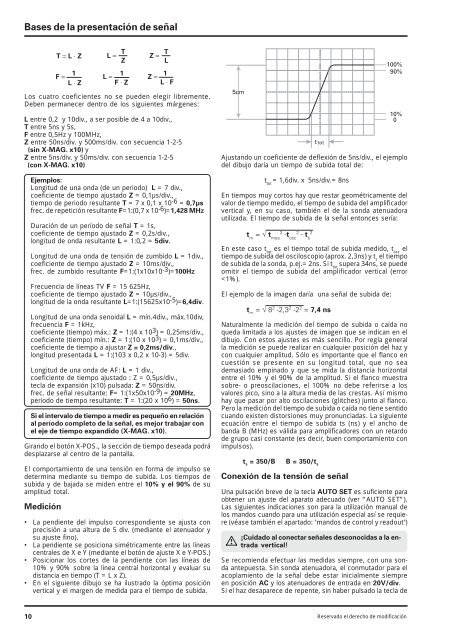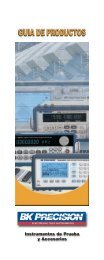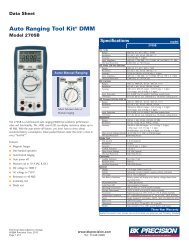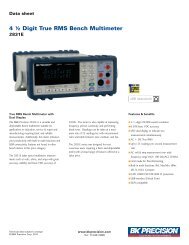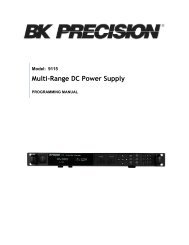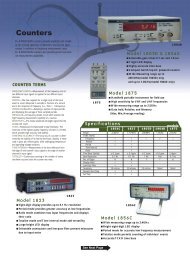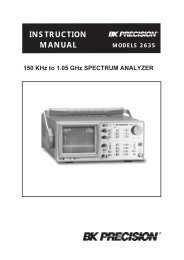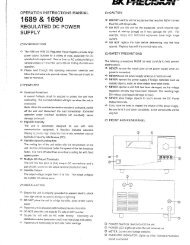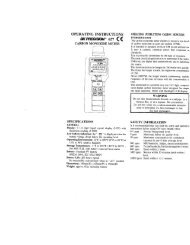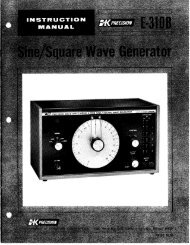El Manual de la Instrucción El Modelo: 5105A - BK Precision
El Manual de la Instrucción El Modelo: 5105A - BK Precision
El Manual de la Instrucción El Modelo: 5105A - BK Precision
You also want an ePaper? Increase the reach of your titles
YUMPU automatically turns print PDFs into web optimized ePapers that Google loves.
Bases <strong>de</strong> <strong>la</strong> presentación <strong>de</strong> señal<br />
= ⋅<br />
= =<br />
. . . . . . . . . . . . . . . . . . . . . . . . . . . . . . . . . . . . . . .<br />
=<br />
⋅<br />
=<br />
⋅<br />
=<br />
⋅<br />
Los cuatro coeficientes no se pue<strong>de</strong>n elegir libremente.<br />
Deben permanecer <strong>de</strong>ntro <strong>de</strong> los siguientes márgenes:<br />
L entre 0,2 y 10div., a ser posible <strong>de</strong> 4 a 10div.,<br />
T entre 5ns y 5s,<br />
F entre 0,5Hz y 100MHz,<br />
Z entre 50ns/div. y 500ms/div. con secuencia 1-2-5<br />
(sin X-MAG. x10) y<br />
Z entre 5ns/div. y 50ms/div. con secuencia 1-2-5<br />
(con X-MAG. x10)<br />
Ejemplos:<br />
Longitud <strong>de</strong> una onda (<strong>de</strong> un periodo) L = 7 div.,<br />
coeficiente <strong>de</strong> tiempo ajustado Z = 0,1µs/div.,<br />
tiempo <strong>de</strong> periodo resultante T = 7 x 0,1 x 10 -6 = 0,7µs<br />
frec. <strong>de</strong> repetición resultante F=1:(0,7 x 10 -6 )=1,428 MHz<br />
Duración <strong>de</strong> un período <strong>de</strong> señal T = 1s,<br />
coeficiente <strong>de</strong> tiempo ajustado Z = 0,2s/div.,<br />
longitud <strong>de</strong> onda resultante L = 1:0,2 = 5div.<br />
Longitud <strong>de</strong> una onda <strong>de</strong> tensión <strong>de</strong> zumbido L = 1div.,<br />
coeficiente <strong>de</strong> tiempo ajustado Z = 10ms/div.,<br />
frec. <strong>de</strong> zumbido resultante F=1:(1x10x10 -3 )=100Hz<br />
Frecuencia <strong>de</strong> líneas TV F = 15 625Hz,<br />
coeficiente <strong>de</strong> tiempo ajustado Z = 10µs/div.,<br />
longitud <strong>de</strong> <strong>la</strong> onda resultante L=1:(15625x10 -5 )=6,4div.<br />
Longitud <strong>de</strong> una onda senoidal L = mín.4div., máx.10div,<br />
frecuencia F = 1kHz,<br />
coeficiente (tiempo) máx.: Z = 1:(4 x 103) = 0,25ms/div.,<br />
coeficiente (tiempo) mín.: Z = 1:(10 x 10 3 ) = 0,1ms/div.,<br />
coeficiente <strong>de</strong> tiempo a ajustar Z = 0,2ms/div.,<br />
longitud presentada L = 1:(103 x 0,2 x 10-3) = 5div.<br />
Longitud <strong>de</strong> una onda <strong>de</strong> AF: L = 1 div.,<br />
coeficiente <strong>de</strong> tiempo ajustado : Z = 0,5µs/div.,<br />
tec<strong>la</strong> <strong>de</strong> expansión (x10) pulsada: Z = 50ns/div.<br />
frec. <strong>de</strong> señal resultante: F= 1:(1x50x10 -9 ) = 20MHz,<br />
período <strong>de</strong> tiempo resultante: T = 1:(20 x 106) = 50ns.<br />
Si el intervalo <strong>de</strong> tiempo a medir es pequeño en re<strong>la</strong>ción<br />
al período completo <strong>de</strong> <strong>la</strong> señal, es mejor trabajar con<br />
el eje <strong>de</strong> tiempo expandido (X-MAG. x10).<br />
Girando el botón X-POS., <strong>la</strong> sección <strong>de</strong> tiempo <strong>de</strong>seada podrá<br />
<strong>de</strong>sp<strong>la</strong>zarse al centro <strong>de</strong> <strong>la</strong> pantal<strong>la</strong>.<br />
<strong>El</strong> comportamiento <strong>de</strong> una tensión en forma <strong>de</strong> impulso se<br />
<strong>de</strong>termina mediante su tiempo <strong>de</strong> subida. Los tiempos <strong>de</strong><br />
subida y <strong>de</strong> bajada se mi<strong>de</strong>n entre el 10% y el 90% <strong>de</strong> su<br />
amplitud total.<br />
Medición<br />
• La pendiente <strong>de</strong>l impulso correspondiente se ajusta con<br />
precisión a una altura <strong>de</strong> 5 div. (mediante el atenuador y<br />
su ajuste fino).<br />
• La pendiente se posiciona simétricamente entre <strong>la</strong>s líneas<br />
centrales <strong>de</strong> X e Y (mediante el botón <strong>de</strong> ajuste X e Y-POS.)<br />
• Posicionar los cortes <strong>de</strong> <strong>la</strong> pendiente con <strong>la</strong>s líneas <strong>de</strong><br />
10% y 90% sobre <strong>la</strong> línea central horizontal y evaluar su<br />
distancia en tiempo (T = L x Z).<br />
• En el siguiente dibujo se ha ilustrado <strong>la</strong> óptima posición<br />
vertical y el margen <strong>de</strong> medida para el tiempo <strong>de</strong> subida.<br />
. . . . . . . . . . . . . . . . . . . . . . . . . . . . . . . . . . . . . . . .<br />
Ajustando un coeficiente <strong>de</strong> <strong>de</strong>flexión <strong>de</strong> 5ns/div., el ejemplo<br />
<strong>de</strong>l dibujo daría un tiempo <strong>de</strong> subida total <strong>de</strong>:<br />
t tot<br />
= 1,6div. x 5ns/div.= 8ns<br />
En tiempos muy cortos hay que restar geométricamente <strong>de</strong>l<br />
valor <strong>de</strong> tiempo medido, el tiempo <strong>de</strong> subida <strong>de</strong>l amplificador<br />
vertical y, en su caso, también el <strong>de</strong> <strong>la</strong> sonda atenuadora<br />
utilizada. <strong>El</strong> tiempo <strong>de</strong> subida <strong>de</strong> <strong>la</strong> señal entonces sería:<br />
En este caso t tot<br />
es el tiempo total <strong>de</strong> subida medido, t osc<br />
el<br />
tiempo <strong>de</strong> subida <strong>de</strong>l osciloscopio (aprox. 2,3ns) y t s<br />
el tiempo<br />
<strong>de</strong> subida <strong>de</strong> <strong>la</strong> sonda, p.ej.= 2ns. Si t tot<br />
supera 34ns, se pue<strong>de</strong><br />
omitir el tiempo <strong>de</strong> subida <strong>de</strong>l amplificador vertical (error<br />


